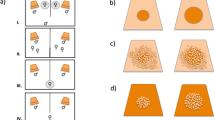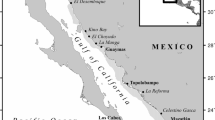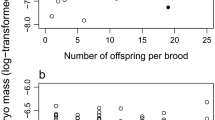Summary
In the pipefish Syngnathus typhle, a species with exclusive male parental care, males limit female reproductive success because of their limited brood pouch space and long pregnancy. Sexual size dimorphism is absent in these 1-year-old animals but increases with age so that older females are larger than similarly aged males. Because fecundity is related to size in both sexes and increases more rapidly with body size in females than in males, the difference in growth increases female fecundity more, relative to male fecundity, as the fish get older. We therefore predicted that male limitation of female reproductive success is even more severe when all age classes are considered. To measure a female's maximum reproductive rate, she was provided with three males. Small 1-year-old females produced as many eggs, or produced eggs at the same rate, as a male of similar size could care for. Small females filled on average 1.06 males within the time span of one male pregnancy and actually produced on average 10 eggs fewer than needed to fill a similarly sized male. Large 2-year-old females, in contrast, produced on average a surplus of 149 eggs and filled 2.7 similarly sized males within the course of one pregnancy. The difference between females of the two size classes was highly significant. Males prefer to mate with larger females if given a choice. In nature sex ratios are equal, and males limit female reproductive success in the whole population. Therefore, small females are more severely constrained by mate availability than are larger females because males choose to mate with larger females.
Similar content being viewed by others

References
Bateman AJ (1948) Intra-sexual selection in Drosophila. Heredity 2:349–368
Berglund A, Rosenqvist G, Svensson I (1986a) Reversed sex roles and parental energy investment in zygotes of two pipefish (Syngnathidae) species. Mar Ecol Prog Ser 29:209–215
Berglund A, Rosenqvist G, Svensson I (1986b) Mate choice, fecundity and sexual dimorphism in two pipefish species (Syngnathidae). Behav Ecol Sociobiol 19:301–307
Berglund A, Rosenqvist G, Svensson I (1988) Multiple matings and paternal brood care in the pipefish Syngnathus typhle. Oikos 51:184–188
Berglund A, Rosenqvist G, Svensson I (1989) Males limit the reproductive success of females in two pipefish species. Am Nat 133:506–516
Breder CM, Rosen DE (1966) Modes of reproduction in fishes. Natural History Press, Garden City
Charnov EL (1982a) Alternative life histories in protogynous fishes: a general evolutionary theory. Mar Ecol Prog Ser 9:305–307
Charnov EL (1982b) The theory of sex allocation. Princeton University Press, Princeton
Daly M, Wilson M (1983) Sex, evolution and behavior, 2nd edn. Williard Grant Press, Boston
Dawkins R (1976) The selfish gene. Oxford University Press, Oxford
Fiedler K (1954) Vergleichende Verhaltensstadien an Seenadeln, Schlangennadeln und Seepferdchen (Syngnathidae). Z Tierpsychol 11:358–416
Gronell AM (1984) Courtship, spawning and social organization of the pipefish, Corythoichthys intestinalis (Pisces: Syngnathidae), with notes on two congeneric species. Z Tierpsychol 65:1–24
Gwynne DT (1981) Sexual difference theory: Mormon crickets show role reversal in mate choice. Science 213:779–780
Gwynne DT (1984) Sexual selection and sexual differences in Mormon crickets (Orthoptera: Tettigonidae, Anabrus simplex). Evolution 38:1011–1022
Gwynne DT (1986) Courtship feeding in katydids (Orthoptera: Tettigonidae): investment in offspring or in obtaining fertilizations? Am Nat 128:342–352
Haresign TW, Schumway SE (1981) Permeability of the marsupium of the pipefish Syngnathus fuscus to [14C]-alpha amino isobutyric acid. Comp Biochem Physiol 69A:603–604
Kronester-Frei A (1975) Licht- und elektronenmikroskopische Untersuchungen am Brutepithel des Männchens von Nerophis lumbriciformis (Pennant 1776), Syngnathidae, unter spezieller Berücksichtigung der strukturellen Veränderung der Eihiille. Forma Functio 8:419–462
Kähnsbauer D (1974) Beitrag zur Kenntnis der Syngnathidaenfauna von Nordeuropa. Ann Naturhist Mus Wien 78:281–290
Lyon BE, Montgomerie RD (1986) Delayed plumage maturation in passerine birds: reliable signaling by subordinate males? Evolution 40:605–615
Maxon SJ, Oring LW (1980) Breeding season time and energy budgets of the polyandrous spotted sandpiper. Behaviour 74:200–263
Oring LW (1986) Avian polyandry. In: Johnston F (ed) Current ornithology, vol 3. Plenum Press, New York, pp 309–351
Petrie M (1983) Female moorhens compete for small fat males. Science 220:413–415
Svensson I (1988) Reproductive costs in two sex role reversed pipefish species (Syngnathidae). J Anim Ecol 57:929–942
Thornhill R, Alcock J (1983) The evolution of insect mating systems. Harvard University Press, Cambridge
Trivers RL (1972) Parental investment and sexual selection. In: Campbell B (ed) Sexual selection and the descent of man, 1871–1971. Aldine, Chicago, pp 136–179
Warner RR, Harlan RK (1982) Sperm competition and sperm storage as determinants of sexual dimorphism in the dwarf surfperch, Micrometrus minimus. Evolution 36:44–55
Warner RR, Robertson DR, Leigh EG (1975) Sex change and sexual selection. Science 190:633–638
Wheeler A (1978) Key to the fishes of northern Europe. Warne, New York
Williams GC (1975) Sex and evolution. Princeton University Press, Princeton
Author information
Authors and Affiliations
Additional information
Offprint requests to: A Berglund
Rights and permissions
About this article
Cite this article
Berglund, A., Rosenqvist, G. Male limitation of female reproductive success in a pipefish: effects of body-size differences. Behav Ecol Sociobiol 27, 129–133 (1990). https://doi.org/10.1007/BF00168456
Received:
Accepted:
Issue Date:
DOI: https://doi.org/10.1007/BF00168456



